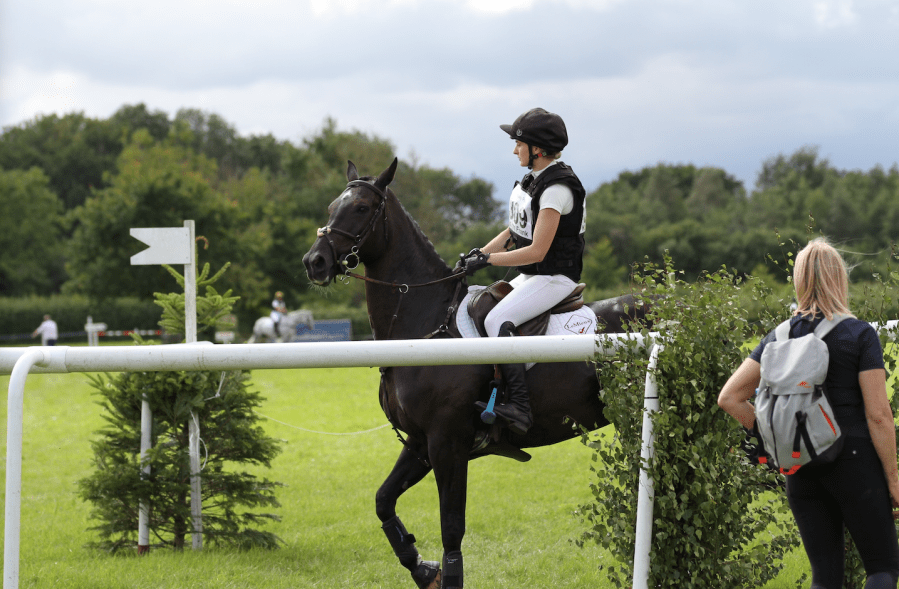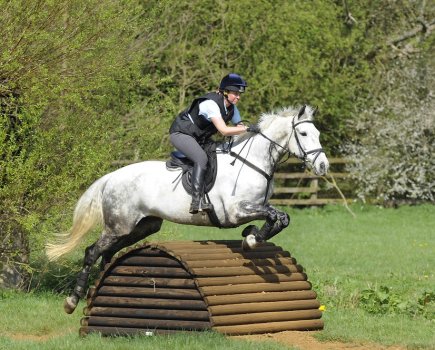The moments you spend inside the cross-country start box set the tone of your cross-country performance.
You wouldn’t leave the technical elements of your cross-country round to chance and it’s no different when it comes to the start — preparing to exit the start box and approach fence one.
The cross-country start box needs to be a stress-free situation for your horse. You might be feeling excitement and apprehension (and chances are your horse will too) before you set off and from this must come a pleasant experience to get you both in the right headspace and your round off to a positive start.
If you spend time watching the cross-country start box at any level of competition, you’ll find that riders do different things according to what best suits their horse.
Some will walk in and stand still to be counted down by the starter, going from halt to canter as soon as they say ‘Go’. Others will stay outside of the start box and trot or canter in, going straight through at the last second.
You’ll see other versions of this happening too. Five-star event rider Emily King has entered numerous cross-country start boxes during her career.
We asked her to help solve some of the common issues riders experience in the start box and this is what she said…
Leaving the collecting ring
After warming up, some horses may be reluctant to leave the collecting ring in order to walk to the cross-country start box.
“It can be strange for horses to leave the other horses and walk down to the start box — they don’t immediately have a job to focus on so they default to hanging back. Some will act like this leaving the lorry park, too,” says Emily.
“Tackling napping means nipping it in the bud early and the signs tend to be subtle: drifting through the shoulder, or backing off the leg.
“Aim to feel your horse very centrally between your hand and leg and correct them firmly as soon as they start to stall. If your horse is young or clingy, it can be best to bring them to events alone so that they don’t have anyone waiting at the lorry to nap to.”
Excitement around the start box
“Don’t expect your horse to stand still at the cross-country start box, they’ll get buzzy and difficult to manage,” advises Emily.
“Instead, show them the start box is nothing to stress about. Walk through the box, out the exit and loop round to come back the other way. The steward will count you down, so try to time your last loop with the final few seconds so you can walk through the box one last time and exit smoothly.
“If the horse is still fidgety, your seat is your superpower. Focus on sitting as softly as you can and ensure your contact isn’t too tight. Even on a strong horse, I tend to hold the reins in one hand,” adds Emily.
“This not only stops you holding on too tightly, but leaves one hand free to pat and reassure the horse.”
Approaching fence one
How you approach fence one depends on your horse.
“I’d always exit the start box with a fairly gradual transition to canter to keep the horse mentally level,” says Emily.
“If your horse is young or spooky, the first fence can be the hardest to get over, so ride positively with your horse between your leg and hand to correct any wiggles — don’t worry about looking too stylish.
“You might be inclined to hold back a bolder horse but remember they won’t be as brave as they will be further on into the course, as they’re just getting started. Make sure the horse is in a positive canter, but don’t gallop them into the fence as this might scare them.”
Refusing at the first fence
Sometimes, a horse may stop at the first fence, especially if they are young and/or inexperienced, and you haven’t got their full attention with them thinking forward as you leave the cross-country start box. This problem is often a sign of an ineffective warm-up routine too.
“Warming up well, with your horse drawing forward and straight to the fences, will help give you both confidence,” explains Emily.
“Don’t accept any wiggles and reward the horse when they get it right. It’s important that you don’t let your guard down with a horse who has a tendency to stop as they could lack confidence for the first few fences.
“Be forthcoming with praise and look for them to find their rhythm. This is when you feel them start to surge forward and lock on when they see a fence,” continues Emily.
“If the horse suddenly starts stopping uncharacteristically, get them examined by your vet. If there’s discomfort you’ll need to work with them to adapt your horse’s training or management, but if all is clear you can keep training in good faith.”
Practice at home
When you go cross-country schooling, see if there is a start box and practise going through it and riding a positive start.
As well as helping a horse become familiar with the start box, it’s a useful of learning how to ride a good cross-country start too. After all, nerves can make us riders do strange things!
I (Aimi) once had a horse who really disliked the start box. He would nap and run backwards; if asked to stand still inside it he would rear up. It was all caused by excitement, and took some managing.
One thing that helped was creating a cross-country start box at home. I placed three pairs of jump wings in a field with a pole on each of them to make an ‘n’ shape.
This was set up in the field for months — and I’d bring it out for a refresher in the spring too. A combination of riding the horse through it regularly (sometimes stopping inside, other times not) and being led through it on the way in from or out to the field helped him learn not to worry.
The start box never became easy before a cross-country round, but it did get better. We very quickly nailed the trotting straight through with two seconds to go — my Dad usually had the task of leading us in — and, generally, the horse went on to jump a clear round.
Emily finished fourth at Badminton earlier this year riding Valmy Biats. She is an ambassador for premium lifestyle clothing brand Joules and daughter of eventing legend Mary. Emily made her five-star debut at the age of just 19, finishing fourth at Pau in France in 2015, and won the under-25 championship at Bramham in 2018.
Main image: copyright Shutterstock. Please note Emily King is not pictured riding










